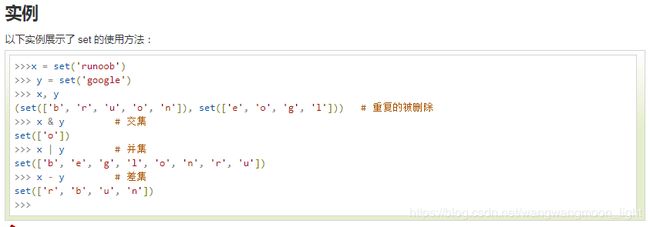LeetCode刷题总结(Python语言版)
编程总结
每每刷完一道题后,其思想和精妙之处没有地方记录,本篇博客用以记录刷题过程中的遇到的算法和技巧
009)回文数
判断一个整数是否是回文数。回文数是指正序(从左向右)和倒序(从右向左)读都是一样的整数。
#-*-coding: utf-8-*-
class Solution:
def isPalindrome(self, x):
if x < 0 or (x > 0 and x % 10 == 0): return False
else:
x = str(x)
return x == x[::-1]
007)整数反转
class Solution:
def reverse(self, x: int) -> int: # "x: int) -> int:" 为类注释
if -10 < x < 10:
return x
str_x = str(x) # 强制转为str类型
if str_x[0] != "-":
str_x = str_x[::-1] # 逆序输出
x = int(str_x) # 强制转化为int类型
else:
str_x = str_x[:0:-1]
x = int(str_x)
x = -x
return x if -2147483648 < x < 2147483647 else 0
if __name__=="__main__":
a = Solution() # 创建i对象,将类实例化
print("the result is", a.reverse(-32326)) # 调用类的方法
349)给定两个数组,编写一个函数来计算它们的交集
示例 1:
输入: nums1 = [1,2,2,1], nums2 = [2,2]
输出: [2]
示例 2:
输入: nums1 = [4,9,5], nums2 = [9,4,9,8,4]
输出: [9,4]
说明:
输出结果中的每个元素一定是唯一的。
我们可以不考虑输出结果的顺序。
题解:
将数组转为set集合处理,利用set集合可以直接求解交集(&)
class Solution:
def intersection(self, nums1, nums2):
"""
:type nums1: List[int]
:type nums2: List[int]
:rtype: List[int]
"""
set1 = set(nums1)
set2 = set(nums2)
return (set2 & set1)
编写一个函数,其作用是将输入的字符串反转过来。输入字符串以字符数组 char[] 的形式给出。
不要给另外的数组分配额外的空间,你必须原地修改输入数组、使用 O(1) 的额外空间解决这一问题。
你可以假设数组中的所有字符都是 ASCII 码表中的可打印字符
class Solution:
def reverseString(self, s: List[str]) -> None:
length = len(s)
if length < 2:
return
for i in range(length//2): # 注意这里的 地板除
s[i], s[length - i -1] = s[length - i -1], s[i]
return
// 称为地板除,两个整数的除法仍然是整数,它总是会舍去小数部分,返回数字序列中比真正的商小的,最接近的数字。
/ 除法计算结果是浮点数,即使是两个整数恰好整除,结果也是浮点数。
387)字符串中的第一个唯一字符
给定一个字符串,找到它的第一个不重复的字符,并返回它的索引。如果不存在,则返回 -1。
s = “leetcode”
返回 0.
s = “loveleetcode”,
返回 2.
chr() 用一个范围在 range(256)内的(就是0~255)整数作参数,返回一个对应的字符。
zip() 函数用于将可迭代的对象作为参数,将对象中对应的元素打包成一个个元组,然后返回由这些元组组成的列表。
class Solution:
def firstUniqChar(self, s: str) -> int:
# hash ,26 个字母为键值的字典
words = [chr(i) for i in range(97, 123)] #[a - z]
values = [0] * 26
wordsDic = dict(zip(words, values))
for word in s:
wordsDic[word] += 1
for i in range(len(s)):
if wordsDic[s[i]] == 1:
return i
return -1
242)有效的字母异位词
给定两个字符串 s 和 t ,编写一个函数来判断 t 是否是 s 的字母异位词。
输入: s = “anagram”, t = “nagaram”
输出: true
class Solution:
def isAnagram(self, s: str, t: str) -> bool:
words = [chr(i) for i in range(97, 123)]
values = [0] * 26
wordsDic_s = dict(zip(words, values)) # 构造一个字典
# 下述中哪个字符串大,将哪个字符串归为字典组,另一个在这个字典组里去重
if (len(s) > len(t)):
for word in s:
wordsDic_s[word] += 1
for i in range(len(t)):
wordsDic_s[t[i]] -= 1
for i in range(len(s)): # 最后检查去重后的结果,如果有非零值,则FALSE
if (wordsDic_s[s[i]] != 0):
return 0
else :
for word in t:
wordsDic_s[word] += 1
for i in range(len(s)):
wordsDic_s[s[i]] -= 1
for i in range(len(t)):
if (wordsDic_s[t[i]] != 0):
return 0
return 1
204)计数质数
统计所有小于非负整数 n 的质数的数量。
示例:
输入: 10
输出: 4
解释: 小于 10 的质数一共有 4 个, 它们是 2, 3, 5, 7 。
class Solution:
def countPrimes(self, n: int) -> int:
if n < 3:
return 0
else:
# 首先生成了一个全部为1的列表
output = [1] * n
# 因为0和1不是质数,所以列表的前两个位置赋值为0
output[0],output[1] = 0,0
# 此时从index = 2开始遍历,output[2]==1,即表明第一个质数为2,然后将2的倍数对应的索引
# 全部赋值为0. 此时output[3] == 1,即表明下一个质数为3,同样划去3的倍数.以此类推.
for i in range(2,int(pow(n, 0.5)+1)): #埃拉托斯特尼筛法已经证明:要得到自然数n以内的全部质数,必须把不大于根号n的所有质数的倍数剔除,剩下的都是质数。
if output[i] == 1:
output[i*i : n : i] = [0] * len(output[i*i : n : i]) #切片:object[start_index : end_index : step], 将所有 i 的倍数(i*i)筛出掉
# 最后output中的数字1表明该位置上的索引数为质数,然后求和即可.
return sum(output)
